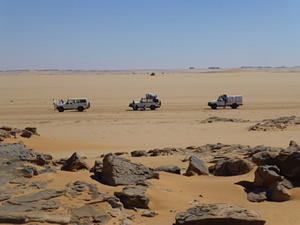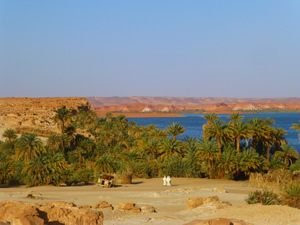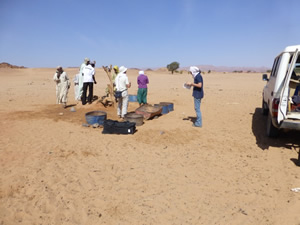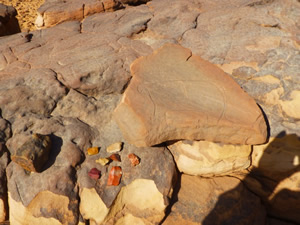
15 January - 7 February 2014, Chad - UNOSAT has successfully participated in a second hydrogeological mission in Northern Chad from 15 January to 7 February 2014, organized under the framework of project ResEAU. This annual scientific field mission, executed by the Ministry of Hydraulics (MHRU), has been conducted over the areas of Faya-Largeau (Borkou), Gouro, Ounianga Kébir and Ounianga Sérir (Ennedi West). The objective was to better understand groundwater occurrences, to decipher geological settings and to validate interpretations carried out from satellite images. Discussions with local authorities on water use were also held.
 The first mission in 2013 was conducted along the southern edge of Ennedi Mountains, from Amdjarass to Fada, and consisted of hydrogeological surveys on wells in wadis and springs at the contact between the Paleozoic sandstones and the underlying granites. To capitalize on this experience, the second scientific mission targeted neighboring territories, where Paleozoic sandstones are followed by younger Mesozoic Nubian Sandstone outcrops. The itinerary included UNESCO's World Heritage Lakes of Ounianga, permanent waterbodies fed by the outflow of a regional fossil aquifer from sugary sandstones.
The first mission in 2013 was conducted along the southern edge of Ennedi Mountains, from Amdjarass to Fada, and consisted of hydrogeological surveys on wells in wadis and springs at the contact between the Paleozoic sandstones and the underlying granites. To capitalize on this experience, the second scientific mission targeted neighboring territories, where Paleozoic sandstones are followed by younger Mesozoic Nubian Sandstone outcrops. The itinerary included UNESCO's World Heritage Lakes of Ounianga, permanent waterbodies fed by the outflow of a regional fossil aquifer from sugary sandstones.
 The three-week mission was rich in observations and findings. ‘’It is now possible to divide the various sandstones in hydrogeological units, characterized by a recharge, a storage, a productivity and a water quality’’ says Ms. Amira Kraiem, UNOSAT Hydrogeologist. Glacial deposits aged Ordovician (450 Ma) identified in the Ennedi region during the 2013 mission were again highlighted near Faya-Largeau. ‘’This observation implies a significant correction of the distribution of sandstone outcrops in the region of Faya’’ says Mr Hamza Brahim, Geologist from the University of N’Djamena. More than 30 water samples were collected at wells during the mission and major physico-chemical parameters were measured in situ. ‘’Such analyses coupled to further chemical and isotopic measurements in laboratories allow a better understanding of groundwater systems feeding the palm plantations of northern Chad, like Faya and Gouro’’ says Ms. Marie-Louise Vogt, UNOSAT Technical Assistant.
The three-week mission was rich in observations and findings. ‘’It is now possible to divide the various sandstones in hydrogeological units, characterized by a recharge, a storage, a productivity and a water quality’’ says Ms. Amira Kraiem, UNOSAT Hydrogeologist. Glacial deposits aged Ordovician (450 Ma) identified in the Ennedi region during the 2013 mission were again highlighted near Faya-Largeau. ‘’This observation implies a significant correction of the distribution of sandstone outcrops in the region of Faya’’ says Mr Hamza Brahim, Geologist from the University of N’Djamena. More than 30 water samples were collected at wells during the mission and major physico-chemical parameters were measured in situ. ‘’Such analyses coupled to further chemical and isotopic measurements in laboratories allow a better understanding of groundwater systems feeding the palm plantations of northern Chad, like Faya and Gouro’’ says Ms. Marie-Louise Vogt, UNOSAT Technical Assistant.
 This mission also led to the discovery of a Neolithic site of primary importance in the region of Lakes Ounianga. ‘’This discovery confirms the hypothesis of a wider extension of the lakes during Sahara’s humid past, on the border of which settlement traces have been encountered’’ affirms Mr Ismael Musa Mohamed, Chief of Mission. The findings and documentation have been remitted to the Centre National d’Appui à la Recherche (CNAR) at N’Djaména and its archeological division.
This mission also led to the discovery of a Neolithic site of primary importance in the region of Lakes Ounianga. ‘’This discovery confirms the hypothesis of a wider extension of the lakes during Sahara’s humid past, on the border of which settlement traces have been encountered’’ affirms Mr Ismael Musa Mohamed, Chief of Mission. The findings and documentation have been remitted to the Centre National d’Appui à la Recherche (CNAR) at N’Djaména and its archeological division.
At the end of the mission, recommendations were shared with Mr Youssouf Sougoudy, Governor of Borkou. "It is advisable to strengthen the regional delegation of the Ministry of Hydraulics, to be able to better control water well and borehole development and to improve the management of water resources at local levels" says Mr Marc-André Bünzli, Head of Water and Environmental Sanitation Expert Group, SDC.
stLight.options({publisher: "17e6b71a-c910-4d4e-a927-c8c18450857c", doNotHash: false, doNotCopy: false, hashAddressBar: false}); var options={ "publisher": "17e6b71a-c910-4d4e-a927-c8c18450857c", "position": "left", "ad": { "visible": false, "openDelay": 5, "closeDelay": 0}, "chicklets": { "items": ["facebook", "twitter", "googleplus", "linkedin", "email", "sharethis"]}}; var st_hover_widget = new sharethis.widgets.hoverbuttons(options);
